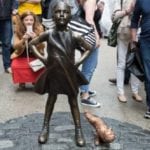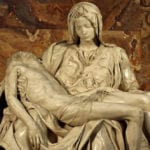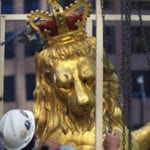 Creepy
Creepy  Creepy
Creepy  Movies and TV
Movies and TV 10 Movies That Get Elite Jobs Right, According to Experts
 Weird Stuff
Weird Stuff 10 Times Real Laws Were Based on Bizarre Hypotheticals
 Animals
Animals 10 Inspiring Tales of Horses Being Human
 Mysteries
Mysteries Top 10 Haunting Facts About the Ghost Ship MV Alta
 History
History 10 Surprising Stories About the Texas Rangers
 Humans
Humans 10 Philosophers Who Were Driven Mad by Their Own Theories
 Miscellaneous
Miscellaneous 10 Video-Game-Worthy Weapons and Armors from History
 Weird Stuff
Weird Stuff 10 Psychics Who Accurately Predicted Wartime Events
 The Arts
The Arts 10 Pieces of Art Inspired by a Broken Heart
 Creepy
Creepy 10 Death Superstitions That Will Give You the Creeps
 Movies and TV
Movies and TV 10 Movies That Get Elite Jobs Right, According to Experts
 Weird Stuff
Weird Stuff 10 Times Real Laws Were Based on Bizarre Hypotheticals
Who's Behind Listverse?

Jamie Frater
Head Editor
Jamie founded Listverse due to an insatiable desire to share fascinating, obscure, and bizarre facts. He has been a guest speaker on numerous national radio and television stations and is a five time published author.
More About Us Animals
Animals 10 Inspiring Tales of Horses Being Human
 Mysteries
Mysteries Top 10 Haunting Facts About the Ghost Ship MV Alta
 History
History 10 Surprising Stories About the Texas Rangers
 Humans
Humans 10 Philosophers Who Were Driven Mad by Their Own Theories
 Miscellaneous
Miscellaneous 10 Video-Game-Worthy Weapons and Armors from History
 Weird Stuff
Weird Stuff 10 Psychics Who Accurately Predicted Wartime Events
 The Arts
The Arts 10 Pieces of Art Inspired by a Broken Heart
Top 10 Times The Statues Came Tumbling Down
We learn from the world around us. Its storied history lies within every street, building, and memorial. Every statue has a unique and interesting story to tell. But while the breakthroughs of our ancestors are inspiring, their mistakes are often difficult to confront.
It is rightly stated that these were men and women of their time, inhabiting a world with values that are utterly alien to most people alive today. To judge historical figures by the cultural orthodoxies of modern America is pure folly.
From the slave owners of the Ottoman Empire to the witch hunters of 18th-century Europe, history is full of monsters and morons. But only through understanding our shared heritage can we hope to produce a genuinely enlightened and tolerant society.
Mao’s Cultural Revolution shows us that erasure of the past, however ugly, is not the answer. The powers that be will always demand more: one more book burned, a final statue toppled.
But once the objects of hate are vaporized in their entirety, there is only one thing left to disappear: people. A healthy society does not build upon the ashes of what came before it but adds to what is already there.
10 Monuments More Controversial Than The Confederate Statues
10 Edward Colston
Britain
Edward Colston remains a sensitive subject in the English city of Bristol. To this day, much of the city’s landmarks are dedicated to the 17th-century merchant and slave trader. Numerous buildings bear his name, including Colston Hall and Colston Tower. Colston Avenue is home to a memorial statue that honors his philanthropic deeds. And local stores sell “Colston buns” to tourists.
From 1681 to 1691, Colston served as an official for the Royal African Company. According to estimates, the mercantile company’s fleet transported 84,000 African slaves, including thousands of children. Around 19,000 slaves died while in transit to the Americas.
Colston would later return to Bristol, his place of birth, and begin philanthropic work. He used some of the money made from slavery, moneylending, and sugar refining to fund the region’s almshouses, schools, and hospitals.
On June 7, 2020, an angry crowd tore down the statue due to Colston’s links to the slave trade. The statue, which had stood in the city center for over 120 years, was then rolled through the streets and thrown into Bristol Harbour. It took the council four days to retrieve the bronze figure from the seabed.[1]
When questioned over the incident, Police Superintendent Andy Bennett offered the following words: “You might wonder why we didn’t intervene and why we just allowed people to put [the statue] in the docks. We made a very tactical decision that to stop people from doing that act may cause further disorder. And we decided the safest thing to do, in terms of our policing tactics, was to allow it to take place.”
9 Gandhi
Ghana
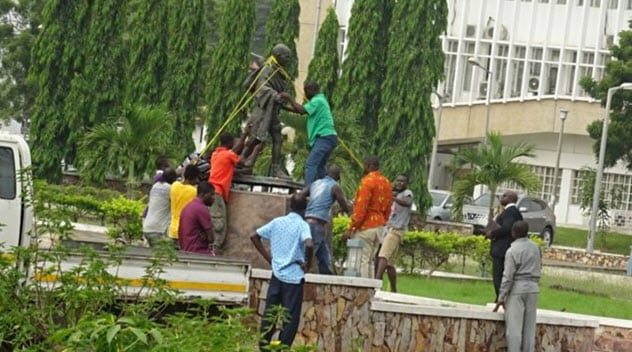
Ghana’s Ministry of Foreign Affairs recently removed a statue of Mohandas “Mahatma” Gandhi from the nation’s capital city, Accra. The statue, unveiled by the 13th president of India Pranab Mukherjee, was supposed to commemorate the renowned anti-colonialist’s peaceful approach to conflict.[2]
Gandhi is considered to have played a pivotal role in ending the British colonial rule of India, mobilizing working-class laborers to protest discrimination. He instructed Indian citizens to boycott British goods and resign from British-run institutions.
Flash forward to 2018. Staff and students at the University of Ghana were opposed to the statue’s very existence. They argued that Gandhi had previously expressed racist opinions. The controversy surrounds Gandhi’s stint as a lawyer in South Africa during the early 1900s.
At the height of the British Empire, Gandhi fought for the civil rights of Indians in South Africa—but not Africans. His detractors also claim he used the racial epithet “kaffirs” to describe “uncivilized” black people. During his early prison years, Gandhi recommended segregation between Indians and black South Africans.
Following a successful #GandhiMustFall campaign, the statue was removed from the campus grounds and stored in a secure location. A year later, the statue was unveiled again at the Kofi Annan Centre of Excellence.
Ghana’s High Commissioner of India stated, “We are confident that relocation of the statue to a prestigious location in Ghana will bring an end to what was a misguided campaign about certain writings of Mahatma Gandhi.”
8 Chief Pontiac
United States
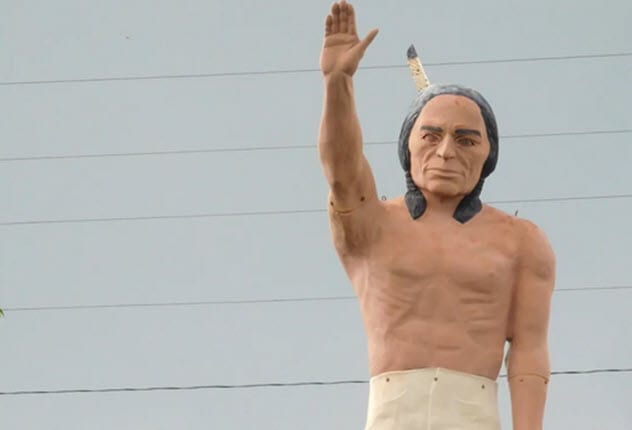
In 2018, a North Carolina dealership lost its most prized mascot. Harry’s on the Hill was once home to an unusual statue: a 7-meter (23 ft) Native American fighter. First erected in 1967, the fiberglass “muffler man” was modeled after the 18th-century warrior Chief Pontiac.
The chief served as an advertisement for GM’s Pontiac cars, which formerly used his likeness as a logo. Chief Pontiac encouraged tribes to attack British-occupied forts and settlements throughout the Midwest. The tribes, unhappy with new trading restrictions, attempted to drive the British from the area. A series of bloody battles ensued, eventually leading to a tentative cease-fire.
In May 2018, a Native American woman had an unfortunate run-in with one of the dealership’s employees. The woman, Sabrina Arch, attempted to buy an SUV but could not afford Harry’s prices. Arch’s attempts to negotiate with the salesperson ended in failure, so she took a two-hour drive to a different dealer.
After finding the right price, she took a photo of her new car and sent it to the previous sales representative at Harry’s. The response was unexpected. The salesperson, thinking he was texting a colleague, called the “cherokee lady on yukon” a “biatch.”[3]
Arch accused Harry’s on the Hill of discrimination and demanded the removal of its Indian mascot. “By having the Indian mascot up as you enter this dealership can be misleading and needs to be taken down,” Arch wrote.
Harry’s complied. The salesperson was immediately fired, and within months, the statue was gone. But the story has a happy ending. A restoration company gave the chief a new lick of paint and moved him to a museum in Michigan.
7 Jefferson, Columbus, And More
United States
Since 2015, protestors have retroactively charged many American legends with racism, white supremacy, and genocide. What started out with the removal of Confederate monuments quickly turned into a purge of random historical figures.
A statue of President William McKinley, a former Union Army soldier, was removed in Arcata, California. In Chicago, a bust of Honest Abe was tarred, set on fire, and eventually removed. And a statue of Joan of Arc was tagged with the words: “tear it down.”
A group of students recently tore down a statue of Thomas Jefferson outside a school in Portland, Oregon. Jefferson, the nation’s third president and a key architect of the US Constitution, oversaw several plantations and owned over 600 slaves. Many protesters are also campaigning to change the school’s name to exclude all references to the Founding Father.
In Richmond, Virginians toppled a statue of Christopher Columbus and hurled it into a nearby lake. In a separate incident, a crowd lassoed a Columbus statue and pulled it down in front of the Minnesota State Capitol building. The angry mob proceeded to kick the inanimate object. Throughout June, authorities nationwide have removed nearly a dozen statues of the 15th-century explorer.[4]
6 Evo Morales
Bolivia
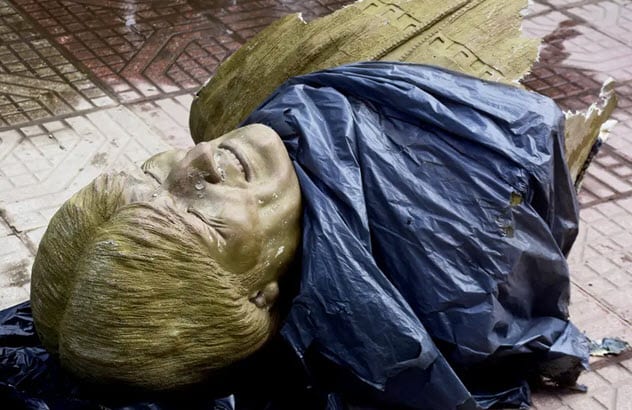
Bolivia is currently undergoing a sort of mini revolution following the ousting of former president Evo Morales. First elected in 2005, the Movement for Socialism leader sought to reduce illiteracy, poverty, and an overreliance on US trade. Morales partially achieved these ambitions, initially leading to a surge in support.
But the former trade unionist’s popularity began to wane after he attempted to bypass the country’s three-term limit. His participation in a fourth election led to violent protests. Morales, accused of orchestrating a power grab, fled the country and went into exile.
Morales made the most of his 14-year stint in power. Statues were erected in his image, streets and buildings were renamed in his honor, and his face appeared on state-funded school computers, soccer shirts, and food products. Morales’s political opponents quickly moved to scrub his image from the public sphere.
In January 2020, the country’s interim sports minister, Milton Navarro, led a group of civilians to the Evo Morales sports stadium in Quillacollo. Armed with sledgehammers, city workers tore down a statue of the disgraced leader and cast it to the ground.
The authorities renamed the stadium the Quillacollo Olympic Sports Center. Navarro explained his actions to the press: “We want to go against the idolatry of Morales.”[5]
10 Weird Things We Have Found Inside Statues
5 Comfort Women
Philippines
In 2017, the Filipina Comfort Women statue was unveiled along the Baywalk waterfront in the Philippine capital of Manila. The bronze statue, depicting a blindfolded woman clutching her gown, represents the Filipino women who were sexually abused during World War II.
During this period, the Japanese Imperial Army established a series of “comfort stations” designed to allow troops to sexually abuse the women of occupied territories. The stations were introduced in response to the mass murders and rapes witnessed during incidents like the Rape of Nanking.
The military hoped that a controlled environment would conceal the sexual violence of its troops and control the spread of venereal diseases. Around 1,000 young Filipino women were coerced or tricked into joining military brothels.
After decades of denial, the Japanese government officially recognized the atrocities in 1993. While the island nation has since offered financial reparations for its past war crimes, the issue remains a sensitive one for both Japan and its neighbors.
Upon learning of the statue, the Japanese embassy in Manila submitted a formal complaint and demanded to know who was responsible for its development. The Philippine government quickly reversed course.
The statue was removed during the dead of night, with city workers leaving behind a massive, rubble-strewn crater. Officials told the public that the statue was temporarily removed in preparation for a drainage project. In reality, the statue was simply handed back to its creator, Jonas Roces.
President Rodrigo Duterte defended the move, saying he did not wish to insult Japan. Manila Mayor Joseph Estrada echoed his leader’s sentiments: “We should bury [the past] along with the bad things that occurred in the past.”[6]
4 John A. Macdonald
Canada
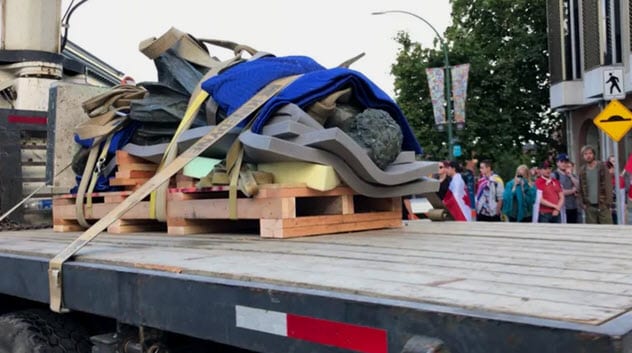
In 1867, the passage of the British North America Act signaled the birth of modern Canada. Sir John A. Macdonald became Canada’s first prime minister, uniting the British colonies of Canada, New Brunswick, and Nova Scotia. He was instrumental in the advancement of the Constitution of Canada and the nation’s economic and geographic expansion.
Around 150 years later, a statue of Macdonald was removed from Victoria City Hall in British Columbia. The decision was made after holding “Truth and Reconciliation” talks with the region’s indigenous tribes, including the Songhees and Esquimalt Nations.
According to the city mayor, Lisa Helps, the talks themselves proved problematic. “One of the things we heard very clearly from the Indigenous family members is that coming to city hall to do this work, and walking past John A. Macdonald every time, feels contradictory.”[7]
So, at a cost of $30,000, the statue was dismantled and put into storage.
Macdonald’s government implemented the Indian Act, which sought to integrate the children of the First Nations into Canadian society. Over the course of a century, tens of thousands of indigenous youngsters were forced to attend Indian residential schools. Some viewed this process, in the words of former Conservative Prime Minister Stephen Harper, as an attempt to “kill the Indian in the child.”
Stories of child abuse at the hands of the Catholic-run schools soon made the national news. To date, Canada has paid billions of dollars in reparations to those affected by the Indian Act.
3 Michael Jackson
Britain
Michael Jackson’s reputation has taken a hit as of late. In early 2019, HBO aired a four-hour documentary film, Leaving Neverland, in which the pop legend was accused of committing child abuse.
The film centers upon allegations made by James Safechuck and Wade Robson. The pair claimed that Jackson had molested them as children during several trips to the singer’s Neverland Ranch in California.
The documentary divided opinion. Jackson’s fans rallied around the late singer, which led to an uptick in sales of his music. The Michael Jackson estate sued HBO for $100 million and accused Safechuck and Robson of inventing a scurrilous tale to make money.
Meanwhile, many radio stations around the world banned the star’s music. Big companies like Louis Vuitton and Starbucks quickly distanced themselves from Jackson’s legacy. And several museums removed his displays.
In 2011, the eccentric billionaire Mohamed Al Fayed unveiled a statue of Michael Jackson in London. The resin sculpture was erected on the grounds of Al Fayed’s former soccer club, much to the bemusement of local sports fans. The landmark was removed in 2013 and eventually relocated to the National Football Museum in 2014.
But HBO’s controversial documentary prompted the museum to permanently remove the statue. Al Fayed offered a calm rebuke: “If some stupid fans don’t understand and appreciate such a gift this guy gave to the world, they can go to hell.”[8]
2 Buddha
China
With President Xi Jinping at the reins of the Chinese Communist Party (CCP), China is slowly crippling freedom of religion. The one-party surveillance state has torn down Catholic churches, shuttled Uighur Muslims into “reeducation camps,” and forced Buddhists to pledge allegiance to the CCP.
Only a handful of religions are permitted in China, and each is kept on a tight leash. Xi’s goons are dispatched from the United Front Work Department to sow secular socialism, devotion to the CCP, and a resentment of Western values.
The Red Dragon has used a series of bizarre excuses to justify the removal, detonation, and concealment of thousands of Buddhist statues. A 24-meter (79 ft) Shakyamuni Buddha was removed in Hunchun City on the grounds of its “disrespectful” exposure to “wind and rain.”
A Guanyin statue, once a national tourist hot spot, was demolished on Xiaolei Mountain for allegedly blocking “the view for airplanes.” And the CCP instructed officials in Jilin City to detonate an impressive 29-meter (95 ft) Buddha, which had taken sculptors 11 years to carve into the mountainside.[9]
The list goes on. Party members have destroyed Buddhist structures because they were too tall, too visible, or placed at nonreligious sites. Statues dedicated to the spiritual leader have been replaced with giant teapots and disguised as lotus flowers.
Over 500 golden Arhat statues in Dongyang were pulverized for having “no educational meaning.” Even paintings of Buddha are replaced with those of President Xi, Karl Marx, and Vladimir Lenin. As if Xi’s intentions were not clear enough, he told a religious conference in 2016 that his followers must serve as “unyielding Marxist atheists, consolidate their faith, and bear in mind the Party’s tenets.”
1 Everything
Iraq
Since the fall of Saddam Hussein, the sectarian divide in Iraq has continued to grow. Thousands of disenfranchised Sunni Muslims, in responding to perceived injustices at the hands of Iraq’s then-Shia prime minister, joined the ranks of ISIS.
By 2014, the terrorist group had taken over one-third of the country and expanded its operations in neighboring Syria. The group conquered and pillaged key cities, taking particular delight in destroying statues and great works of art. Jihadists ransacked the Mosul Museum, toppling statues with sledgehammers.
Nimrud, an archaeological dig site, was completely devastated. And the leaning Al-Hadba’ minaret (aka the hunchback) was demolished using explosive devices. The public library suffered a similar fate, resulting in the loss of thousands of precious manuscripts.
Elsewhere, a 9-ton winged bull—one of two sentinels guarding the Gates of Nineveh—was razed using a jackhammer. The proud beast had the head of a human, the wings of an eagle, and the torso of a bull. Its creators believed the statue would afford spiritual protection to the Assyrian king of Mesopotamia.
Throughout ISIS-controlled Iraq, such ancient treasures disappeared on an unimaginable scale.[10]
ISIS justified the carnage using a range of religious, political, and historical arguments. Islamists claimed they were following in the footsteps of the prophet Muhammad, who destroyed statues to discourage idolatry. However, it turned out the group was using stolen artifacts to fund its military efforts, which belittled its already tenuous position.
Top 10 Controversial Statues Around The World



